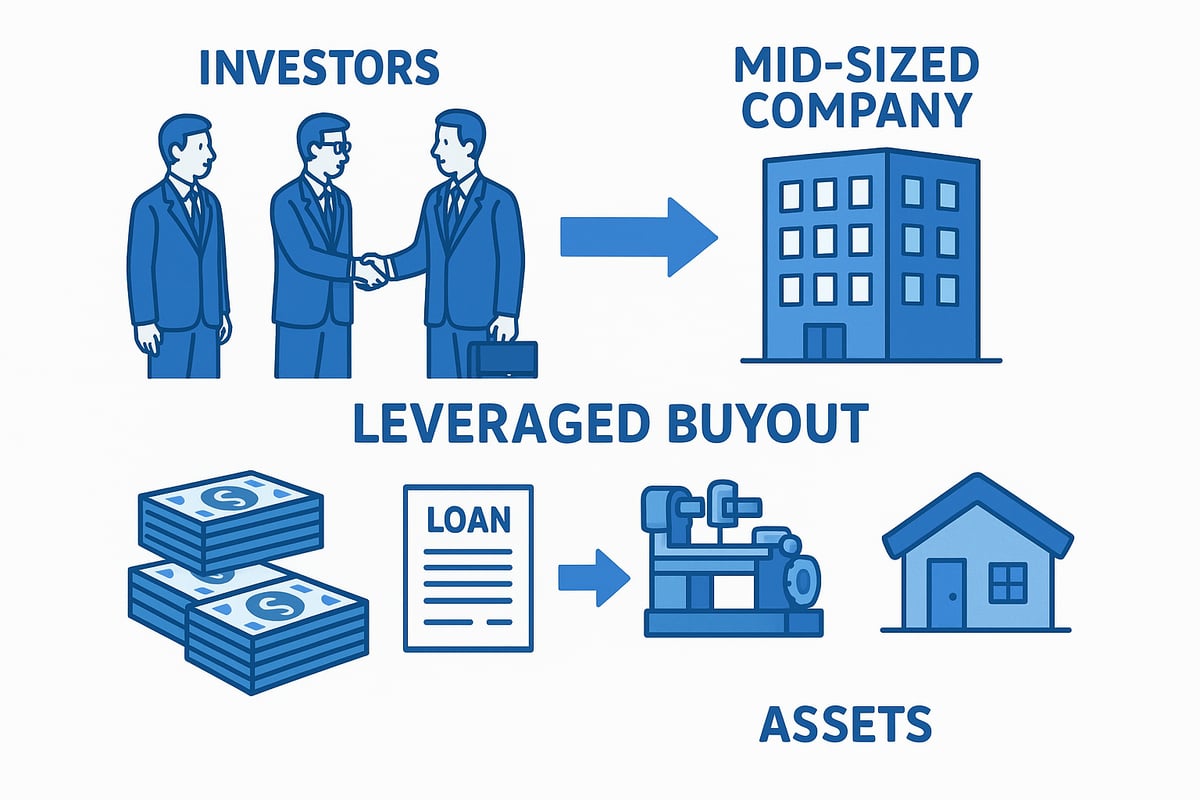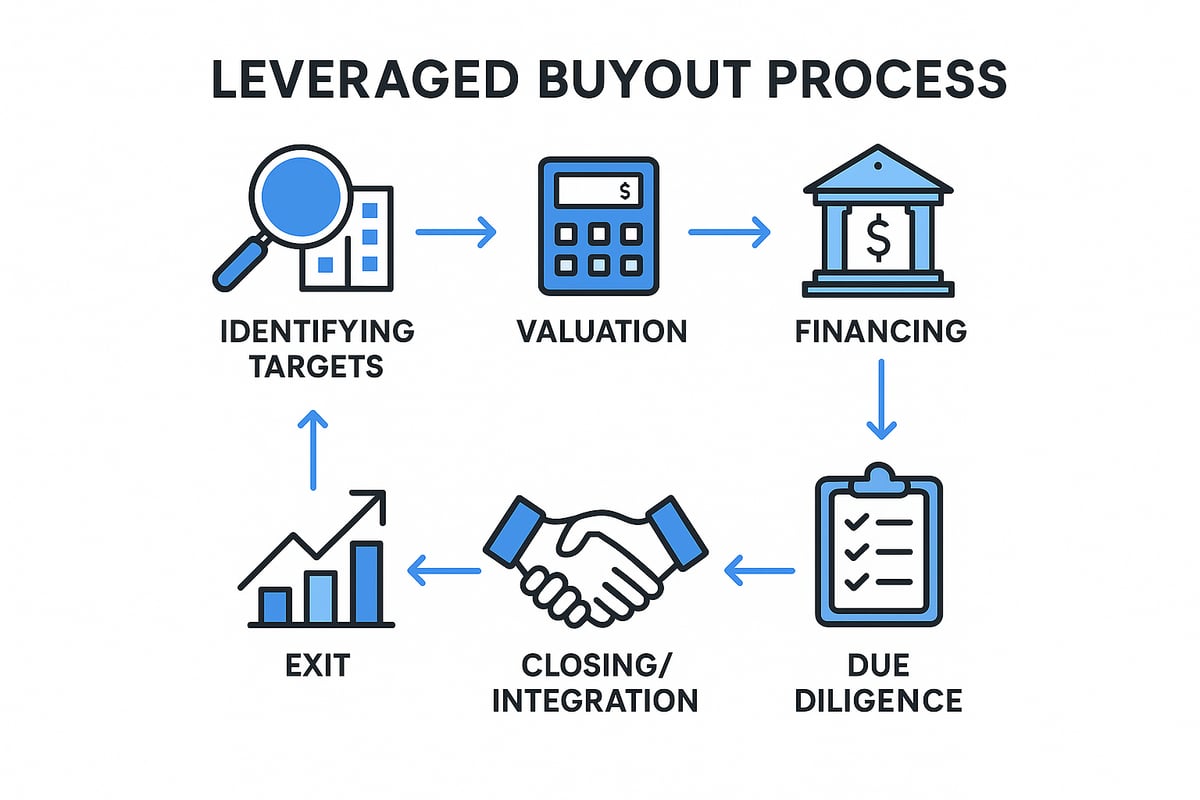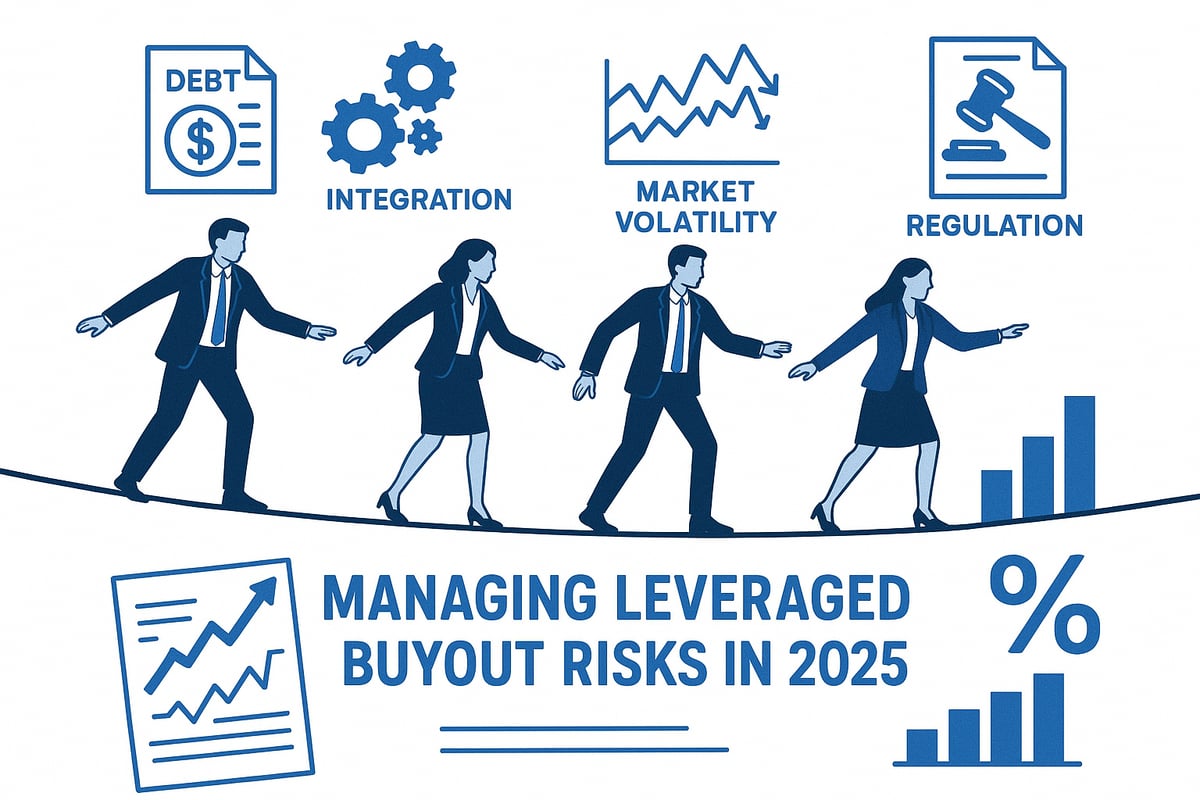Leveraged Buyout Guide: Strategies and Insights for 2025
As economic cycles continue to shift, the leveraged buyout is emerging as a vital strategy for both investors and business owners in 2025. Amid market uncertainty, LBOs offer unique opportunities for high returns and strategic growth.
This guide demystifies the leveraged buyout process, delivering expert insights and actionable strategies tailored for today’s financial landscape. You will explore core LBO fundamentals, step-by-step deal structures, cutting-edge approaches for 2025, risk management techniques, and the latest market trends shaping the future.
Unlock the knowledge and tools needed to make smarter investment decisions. Let’s dive in and turn complex concepts into practical advantages.
Understanding Leveraged Buyouts: Fundamentals and Key Concepts
A leveraged buyout is a powerful financial strategy that allows investors to acquire a company primarily using borrowed funds. Typically, 70 to 80 percent of the purchase price is financed with debt, with the target company’s own assets serving as collateral. This approach sets leveraged buyouts apart from standard M&A transactions, which often use a higher proportion of equity. Common participants include private equity firms, management teams, and investment consortiums. One of the most famous leveraged buyout examples is the RJR Nabisco deal, which defined the mega-buyout era and demonstrated both the appeal and risks of this structure.

What Is a Leveraged Buyout?
In a leveraged buyout, the acquirer secures a controlling interest in a business by using a significant amount of debt. The acquired company’s assets and cash flow are pledged to secure this financing, enabling investors to amplify returns while minimizing their upfront capital. Unlike traditional acquisitions, a leveraged buyout is characterized by its reliance on outside financing rather than equity alone. Private equity sponsors, management teams, and even consortia may pursue these deals, seeking to unlock value through operational improvements or strategic repositioning. The historic RJR Nabisco leveraged buyout remains a textbook example, illustrating both the scale and complexity involved.
Types of LBO Structures
Leveraged buyout transactions can take several forms, each with unique motivations and structures. Management buyouts (MBOs) occur when a company’s management team leads the acquisition, aligning ownership with operational control. Secondary buyouts (SBOs) involve a sale from one private equity firm to another, while public-to-private buyouts take publicly traded companies private. Hostile takeovers can also use the leveraged buyout approach, proceeding without management’s consent. In 2025, hybrid models and innovative structures are emerging, blending elements of these types to adapt to evolving market demands. Each structure tailors the leveraged buyout to fit specific strategic goals and market opportunities.
Key Players and Stakeholders
Several critical parties drive a leveraged buyout from inception to completion. Private equity sponsors provide expertise and capital, while lenders such as banks, private credit funds, and mezzanine financiers supply the necessary debt. The target company’s management and employees are essential for operational continuity and integration. Limited partners (LPs) invest equity capital, seeking attractive returns. Regulatory bodies and advisors, including legal, tax, and financial consultants, ensure compliance and help navigate complex transactions. Each stakeholder plays a pivotal role in the leveraged buyout process, shaping outcomes and aligning interests for successful deals.
Advantages and Drawbacks of LBOs
A leveraged buyout offers several advantages, including the potential for enhanced returns, operational improvements, and strategic flexibility. By using high levels of debt, investors can amplify gains if the company performs well. However, this structure also introduces significant risks. Overleveraging can strain cash flow and increase the chance of default, especially if market conditions shift. Cost-cutting and restructuring may impact employees and culture. According to recent data, debt-to-equity ratios in leveraged buyouts often reach 70 to 80 percent, magnifying both opportunity and risk. For a deeper look at how leverage impacts deal structure and risk, see the debt-to-equity ratio explained. Notable successes demonstrate the upside, while failed buyouts highlight the importance of prudent risk management.
LBOs in the 2025 Market Context
In 2025, leveraged buyout trends reflect a shift toward lower debt ratios and an increased focus on operational value creation. Economic conditions, including rising interest rates and fluctuating credit market liquidity, shape deal structures and outcomes. Regulatory changes are prompting more transparency and careful risk assessment. Recent deal volumes remain robust, but performance metrics show a clear emphasis on sustainable value and disciplined leverage in the evolving leveraged buyout landscape.
Step-by-Step Guide to the Leveraged Buyout Process
Navigating a leveraged buyout requires precision, strategy, and a clear understanding of each stage. This step-by-step guide breaks down the process, making even complex transactions accessible for investors and operators in 2025.

1. Identifying and Screening Target Companies
The first step in any leveraged buyout is pinpointing the right business. Ideal targets are mature companies with consistent cash flows and strong EBITDA margins, typically above 15 percent. These firms often operate in stable industries like healthcare or consumer staples, providing resilience in economic downturns.
Key criteria for screening include:
- Predictable revenue streams
- Low capital expenditure requirements
- Strong market position
- Potential for operational improvements
Private equity teams use advanced market intelligence tools to identify undervalued mid-market firms. A careful selection process increases the probability that the leveraged buyout will deliver value.
| LBO Target Traits | Description |
|---|---|
| EBITDA Margin | >15 percent |
| Industry Stability | Non-cyclical sectors |
| Cash Flow Predictability | High |
2. Valuation and Purchase Price Negotiation
Valuing a leveraged buyout candidate is both science and art. Investors rely on methods such as comparable company analysis, precedent transactions, and discounted cash flow (DCF) models. Accurate valuation ensures the deal is financially sound and supports future returns.
Negotiating the purchase price often involves bridging gaps between buyer and seller expectations. Tools like earn-outs or contingent payments can help align interests. Advisors provide fairness opinions to validate the price and protect all parties involved.
A disciplined approach to valuation and negotiation is critical for a successful leveraged buyout, especially in competitive markets.
3. Structuring the Acquisition Financing
Financing is at the heart of every leveraged buyout. The capital stack typically includes senior debt, mezzanine debt, and equity. In 2025, leverage levels commonly range from 5 to 6 times EBITDA, reflecting a cautious approach by lenders.
Choosing between banks and private credit funds is an important decision. Private credit has gained ground, offering flexible terms and faster execution. The use of the target’s assets as collateral is standard practice.
For insights into evolving debt structures and pricing, see Debt Trends - Market Trends 2025. Understanding these trends is vital for optimizing the leveraged buyout capital structure.
4. Due Diligence and Risk Assessment
Thorough due diligence is non-negotiable in a leveraged buyout. This stage covers financial, legal, and operational reviews to identify hidden risks. Red flags can include undisclosed liabilities or regulatory challenges.
In 2025, environmental, social, and governance (ESG) factors are increasingly part of the assessment. Data analytics and artificial intelligence help teams uncover issues faster and more accurately.
Missed risks during due diligence can lead to deal failure. A rigorous process ensures the leveraged buyout stands on a solid foundation.
5. Closing the Deal and Post-Acquisition Integration
Once financing and diligence are complete, legal documents are finalized and funds are transferred. Change of control is managed with careful transition planning.
Successful integration focuses on realizing synergies and aligning leadership. Communication with employees and stakeholders is essential to maintain trust.
Best practices in the leveraged buyout process include structured handovers and clear post-close strategies, ensuring value creation from day one.
6. Exit Planning and Value Realization
Planning the exit begins early in the leveraged buyout lifecycle. Common strategies include IPOs, secondary buyouts, or strategic sales. The average holding period ranges from three to seven years.
Preparing the company for exit involves enhancing performance and ensuring operational readiness. Well-timed exits maximize investor returns.
Recent market data highlights that successful leveraged buyout exits are often driven by operational improvements and favorable market conditions.
Advanced LBO Strategies and Innovations for 2025
Private equity professionals are reimagining the leveraged buyout playbook in 2025. With shifting economic conditions and emerging technologies, advanced strategies are crucial for generating value and managing risk. This section explores the most impactful innovations shaping the leveraged buyout landscape today.

Operational Value Creation Beyond Cost-Cutting
In 2025, the leveraged buyout approach focuses on value creation that extends well beyond traditional cost-cutting. Investors are leveraging technology to automate workflows, streamline supply chains, and unlock new efficiencies.
Strategic M&A add-ons and bolt-on acquisitions help expand product lines and enter fresh markets. Revenue growth initiatives, such as digital sales channels and innovative pricing models, are gaining traction.
Optimizing human capital through leadership development and targeted training also drives performance. Recent leveraged buyout case studies highlight how tech-enabled improvements can boost EBITDA and foster sustainable growth.
Financing Innovations and Trends
Financing strategies for a leveraged buyout have evolved rapidly. The rise of private credit and non-bank lenders offers greater flexibility in deal structuring. Unitranche and hybrid debt instruments are increasingly popular, blending senior and subordinated debt into a single facility.
ESG-linked and sustainability-focused loans are now common, aligning financing terms with responsible business practices. The current interest rate environment requires careful capital stack planning to balance risk and reward.
According to the Leveraged Finance Market Research Report 2033, the private credit market is projected to grow significantly, influencing how leveraged buyout deals are financed worldwide.
Deal Sourcing and Competitive Advantage
Securing a strong deal pipeline is key to leveraged buyout success. Private equity firms are prioritizing proprietary deal sourcing over crowded auction processes. Building deep industry relationships and leveraging networks gives buyers an edge.
AI and big data analytics are transforming how targets are identified and evaluated. Cross-border leveraged buyout activity is rising, as firms pursue global expansion and diversification.
A recent example is a consumer sector buyout where proprietary sourcing led to less competition and more favorable pricing, underscoring the importance of innovative sourcing techniques.
Risk Mitigation and Downside Protection
Mitigating risk is central to every leveraged buyout strategy in 2025. Dealmakers structure robust covenants and negotiate downside protections to shield against unexpected events. Interest rate and currency risk are often hedged using derivatives.
Insurance products, such as reps and warranties insurance, are increasingly used to manage transaction risk. Portfolio diversification and detailed scenario planning help firms weather market volatility.
LBOs that survived the 2020-2023 downturn did so by prioritizing flexible financing and proactive risk management, proving these tools' effectiveness in turbulent times.
Regulatory and ESG Considerations
Regulatory changes are reshaping the leveraged buyout environment. New rules affecting leverage limits and disclosure requirements demand rigorous compliance. ESG due diligence is now a standard part of the process, with investors scrutinizing environmental, social, and governance factors.
Stakeholder activism and greater public scrutiny mean that buyout firms must be transparent and responsive. Data shows a rise in ESG-focused LBO funds, and deals in 2025 are often structured to meet sustainability targets.
Recent transactions demonstrate that integrating ESG criteria can influence deal terms, enhance reputational value, and drive long-term success.
Risks, Challenges, and Risk Management in LBOs
Navigating a leveraged buyout means facing a unique set of risks that can impact deal success and long-term value. Understanding these challenges is critical for investors, management, and stakeholders alike. Let’s break down the main risk categories and explore proven risk management strategies for each.

Financial Risks and Overleveraging
Financial risk sits at the heart of any leveraged buyout. High levels of debt can strain cash flows and increase the risk of default, particularly if interest rates rise or earnings fall short. The interest coverage ratio is a key metric for assessing the ability to service debt in a leveraged buyout—learn more about this vital indicator with the interest coverage ratio basics.
Historical examples highlight the dangers of overleveraging, with some high-profile LBOs ending in bankruptcy. According to industry data, default rates among LBO-backed companies can spike during economic downturns. To reduce risk, deal teams often cap leverage ratios, stress test financials, and maintain strong liquidity buffers.
Operational and Integration Risks
Operational and integration risks often emerge after the leveraged buyout closes. Cultural clashes between new owners and existing management, talent attrition, and failure to realize projected synergies can erode value quickly.
Integration failures, such as mismatched systems or leadership disputes, have derailed even promising deals. For example, abrupt cost-cutting may disrupt workflows, while unclear communication can undermine morale. Best practices include detailed integration planning, clear leadership roles, and ongoing stakeholder engagement to ensure a smooth transition.
Market and Economic Risks
A leveraged buyout is sensitive to shifts in market conditions. Economic downturns, industry-specific headwinds, and market volatility can all affect the ability to meet debt obligations and achieve growth targets.
For instance, LBOs completed just before the COVID-19 pandemic faced unexpected revenue declines and tighter credit. Data consistently shows that leveraged buyout performance diverges in bull versus bear markets. Scenario analysis, contingency planning, and diversification across sectors can help mitigate exposure to these unpredictable risks.
Legal, Regulatory, and Reputational Risks
Legal and regulatory risks are rising for leveraged buyout transactions. Antitrust challenges, new regulations around leverage, and increased scrutiny on transparency can slow or block deals.
Public perception and stakeholder activism also pose reputational risks, especially if layoffs or environmental concerns arise. High-profile regulatory interventions in recent years have reshaped deal structures and disclosure practices. To manage these risks, sponsors prioritize compliance, proactive communication, and robust governance frameworks.
Leveraged Buyout Market Outlook and Trends for 2025
The leveraged buyout market in 2025 is evolving quickly as investor priorities, deal structures, and global dynamics shift. Cutting-edge strategies and a focus on operational value are shaping the future of leveraged buyout activity. Let us explore the most important trends and insights driving this landscape.
Deal Volume, Size, and Sector Trends
Leveraged buyout deal volumes in 2025 are holding steady, with a moderate uptick in mid-market transactions. Sectors like technology, healthcare, and industrials continue to attract significant activity as firms seek resilient business models.
Private equity buyers are shifting focus toward smaller, cross-border deals as valuations in mega-deals remain high. According to the Mapping the Markets: Q3 2025 report, private equity and private credit have outperformed traditional asset classes so far this year. Notable leveraged buyout transactions include tech-enabled healthcare rollups and industrial carveouts, reflecting sector-specific growth drivers.
Evolving Role of Private Equity and Lenders
Private equity is playing a more active role in corporate governance, driving strategic change and operational improvements within portfolio companies. The growing presence of non-bank lenders and private credit funds has reshaped leveraged buyout financing, providing flexible capital solutions.
Limited partners are demanding greater transparency and alignment with long-term value creation. The 2025 Leveraged Loan Market Survey highlights lender optimism, with robust fundraising and high levels of dry powder. Private equity-led industry consolidation is also a major trend, further supporting leveraged buyout market growth.
Technological Disruption and Digital Transformation
Technology is transforming every aspect of the leveraged buyout process. Advanced analytics, artificial intelligence, and automation are now central to deal sourcing, due diligence, and post-acquisition value creation.
Firms are targeting companies with strong digital capabilities or those ripe for digital transformation. Tech-driven leveraged buyout deals consistently outperform peers by capturing new efficiencies and revenue streams. Adoption of digital tools is at an all-time high, making technology a key lever in 2025’s competitive landscape.
ESG and Sustainable Investing in LBOs
ESG factors are now core to leveraged buyout strategy. Investors increasingly demand integration of environmental, social, and governance metrics into due diligence and portfolio management.
Sustainability-linked loans and ESG reporting are not just regulatory requirements, but also value drivers and risk mitigators. ESG-focused leveraged buyout funds are delivering competitive returns. In 2025, the volume of ESG-linked deals is rising, as firms position themselves for long-term success and stakeholder trust.
Geographic Shifts and Globalization
Cross-border leveraged buyout activity is accelerating, with Asia-Pacific, Europe, and emerging economies drawing increased attention. Currency volatility and geopolitical risk are top considerations for dealmakers.
Notable global leveraged buyout case studies highlight the importance of local market knowledge and regulatory navigation. As globalization continues, firms that adapt quickly to regional trends and risks are best positioned to capture new opportunities in the evolving leveraged buyout market.
LBO Case Studies and Lessons Learned
Examining real-world leveraged buyout transactions provides invaluable lessons for investors and business owners. These case studies highlight both the potential and the pitfalls of this powerful financial tool. Understanding what drives success, what causes failure, and how innovative models are evolving can inform smarter strategies in today’s dynamic market.
Landmark LBOs: Success Stories
The RJR Nabisco leveraged buyout in the late 1980s stands as a classic example, demonstrating both the scale and complexity of such deals. Led by KKR, this transaction set records at the time and shaped the private equity industry for decades. More recently, successful exits between 2023 and 2025 have underscored the importance of operational improvements and strategic pivots.
Key metrics from top-performing leveraged buyout deals often include strong IRR (Internal Rate of Return) and MOIC (Multiple on Invested Capital):
| Deal | IRR (%) | MOIC (x) |
|---|---|---|
| RJR Nabisco | 19 | 2.5 |
| Recent Tech LBO | 25 | 3.2 |
| Healthcare LBO | 22 | 2.8 |
What sets winners apart is a clear focus on value creation, disciplined execution, and adapting to changing market conditions. For more context on the role of private equity in these transactions, see this private equity overview.
LBO Failures and Cautionary Tales
Not all leveraged buyout deals lead to positive outcomes. High-profile defaults and bankruptcies, such as the collapse of Toys “R” Us, reveal common pitfalls. Major causes of failure include:
- Excessive leverage that strains cash flow
- Overestimating market growth or synergies
- Ineffective post-acquisition integration
Industry data shows that loss rates in failed leveraged buyout transactions can reach 30% or more, especially during downturns. Recovery statistics emphasize the importance of prudent risk management and conservative leverage ratios. Learning from these cautionary tales helps investors avoid repeating costly mistakes and highlights the need for robust due diligence.
Management Buyouts and Employee-Led LBOs
A management buyout is a type of leveraged buyout where a company’s existing management team acquires the business, often to drive long-term growth and preserve company culture. The structure typically aligns incentives between management and investors, but it also presents unique challenges:
- Securing appropriate financing
- Ensuring stakeholder alignment
- Navigating cultural shifts during transition
Recent successful management buyouts in the mid-market segment have demonstrated that strong leadership and clear communication are vital for a smooth transition. For a deeper dive into structures and incentives, visit this management buyout definition. Data shows MBOs account for a significant share of LBO activity, with favorable outcomes when teams are well-prepared.
Innovative and Emerging LBO Models
The leveraged buyout landscape is rapidly evolving, with new models gaining traction. Minority stake LBOs and growth buyouts are enabling investors to participate in upside while sharing risk. ESG (Environmental, Social, and Governance) and impact-driven leveraged buyout funds are on the rise, reflecting investor demand for responsible investing.
Emerging trends include:
- Use of SPACs and alternative vehicles for acquisition
- ESG mandates influencing deal terms and reporting
- Hybrid financing structures to balance risk and return
A notable example is the launch of ESG-mandated leveraged buyout funds in 2025, which prioritize sustainability and stakeholder engagement. As these innovative models become mainstream, they offer fresh avenues for value creation and risk mitigation in the leveraged buyout market.
As you explore the evolving landscape of leveraged buyouts in 2025, it becomes clear how much there is to learn from the past—whether it’s recognizing patterns behind legendary successes or understanding the pitfalls others have faced. That’s why we’re building a platform designed to empower you with interactive charts, AI-powered insights, and original coverage that put today’s deals in historical context. If you’re ready to deepen your understanding and make smarter decisions by learning from both past and present market movements, I invite you to Stay ahead by looking back.
